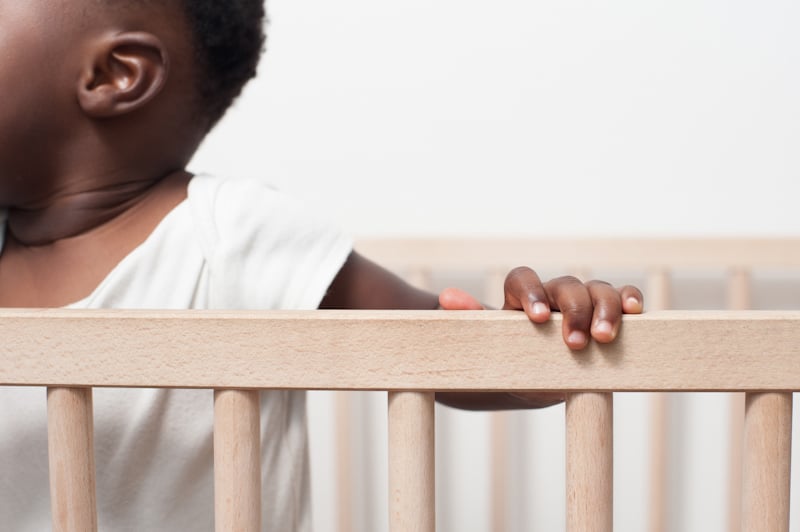
10 Gentle Sleep-Training Tips For Moms Who Don’t Want To CIO
Written by Patrice D'Agostino and Moorea Malatt
Photography by Maria del Rio
Getting your baby to sleep better is every parent’s goal. However, letting your little one “cry it out” (a.k.a. CIO) to achieve it isn’t always an option. Which is why we tapped parenting support coach Moorea Malatt of Savvy Parenting Support to share ten gentle tips to encourage better sleep rhythms for babies and toddlers. As a post-partum doula, night nanny, and mom, Moorea has crafted a sleep program for co-sleeping and crib-sleeping families who are interested in sleep strategies other than the infamous CIO approach. Below, she offers a range of tips and tricks to allow parents to tailor a gentle sleep training method for their individual child. Read up!
Bed Time “7 p.m. is an ideal baby and toddler sleep hour. Babies who go to bed around this time are more likely to sleep for a longer stretch of hours each night. This number might be flexible by a half hour or an hour, gradually changing with the seasons and changes in light. Black-out curtains/shades really help children sleep longer and better, and can help with napping, as well. Of course, 7 p.m.-ish isn’t the only option. Plenty of families find alternate schedules and that’s ok! Overall, sleep times have to work for the whole family.”
Stimulation “Make sure that a child over 3 months has enough stimulation throughout the day and not too much stimulation directly before sleep time. Reading books to your baby, getting in lots of tummy time and crawling, outdoor time with fresh air, talking and singing to baby and social interaction with other adults and children can all help babies become tired in a good way. Back off on stimulation when baby becomes cranky to avoid overstimulation and avoid loud activity and new social stimulation right before nighttime sleep.”
The Oral Sleep Association. “Make sure that baby doesn’t fall asleep with breast, bottle, or pacifier in mouth. A before-bed or before-nap feeding is wonderful, but babies who fall asleep with something in the mouth will wake all the way up during a natural rise in the sleep cycle, believing that the only way to fall back asleep is to drink again. This is natural and normal conditioning, but it is associated with more frequent nighttime waking. Without this sleep association, babies have more opportunity to learn to move a bit or roll over and fall back asleep with less help. This hardest of changes can bring about the biggest sleep improvement.”
Night Routine “A bedtime routine for nights can begin as early as 3 months and can, with consistency over time, become a sleep signal. Bath, before-bed feeding/snack, books, and singing is a good order to use. Most parents are content with providing a routine for their children until 6 years or later.”
Daytime Variation “Varying the sleep situation can prevent baby from getting attached to only one way of sleeping. You need to be able to go on vacation and not have a sleep disaster. Where routine is excellent for nighttime sleep, variation in sleep situations is great for daytime naps. Encourage baby to sometimes sleep in the car, while being worn, in the stroller, on a mattress, both in light and dark area, in quiet and a little noise. It can be tempting to keep a new baby home all of the time to try to encourage consistent sleep, but most families eventually find they wish for more flexibility.”
Calories “Work on a 24-hour sleep plan that encourages more calories during the day, so that less calories are needed at night. Babies who are distracted during feedings may benefit from feeding a little bit further apart and in a quiet place away from people to encourage a quality feed. Older babies who are enjoying table foods can be encouraged, when ready, to enjoy more whole carbs and proteins alongside their fruits and veggies.”
Temperature and Clothing “The ideal temperature for baby and toddler sleep is 67-68 degrees at night. Humans sleep better when we are not too hot. Babies should not sleep with blankets over them and toddlers often kick them off. With a room at ideal temperature, long-sleeve cotton shirts, pants, and socks (even if they are kicked off) are enough. You will know your child is too cold if hands and feet are cold when they have been asleep for at least an hour.”
Adjust Nap Hours. “Babies over 6 months old who have naps very close to bedtime (still sleeping after 4:30 p.m.) or who have napped too many hours in the day often have a much harder time getting to bed at night and wake more frequently. Nighttime sleep becoming worse may be a sign that baby may be ready to transition to 2 naps from 3 or to 1 nap from 2. A period of daytime sleep longer than 2.5 hours at one time for a child older than a year may cause problems for nighttime sleep. Total daytime sleep needed depends on your child’s age and many other factors. Make any changes to naps gradually and gently, but waking a baby to prevent a too long daytime nap isn’t cruel if it saves everyone’s nighttime sanity.”
The Roll-Over. “Much in the same way that you may have heard people talk about a ‘dream feed’ for newborns to fill the tummy and re-set the sleep cycle to try and prevent a first nighttime wake-up, just a little nudge and a kiss or rolling the baby to his side can be enough to re-set a sleep cycle for baby before he fully wakes up again. This may allow parents to go to bed at a decent hour without fear that baby will wake up as soon as the parents drift off.”
Sleep When the Baby Sleeps “Allowing yourself to get more sleep will lessen your anxiety about sleep and less anxiety in the home can help everyone sleep better. Also, modeling sleep for your baby and child is one of the best secrets to solving sleep avoidance. Modeling can include, ‘Look at me, my head is on the pillow, my eyes are closed’ or just having a dark and quiet house during the time you expect baby to fall asleep, so she doesn’t feel she is missing out on the fun.”
If It Ain’t Broke, Don’t Fix It “Nursing on demand and going with your baby’s cues is natural and beneficial. Don’t change your sleep situation unless you are really facing a challenge—feeling emotionally and physically drained, worried about a job, unable to take care of basic tasks. Beware of sleep trainers and authors who recommend sleep methods that might hurt your breastfeeding relationship or aren’t gradual, as this can lead to mood challenges for both mother and child and that may not be worth the sleep benefit. The tips above are for families that have parents who really feel they need to make changes to the sleep status quo for parental physical and mental health or for baby to get more rest, as well.”
Need more Savvy Parenting Support? Find out more about Moorea’s online workshops and one-on-one coaching services here.
Share this story




